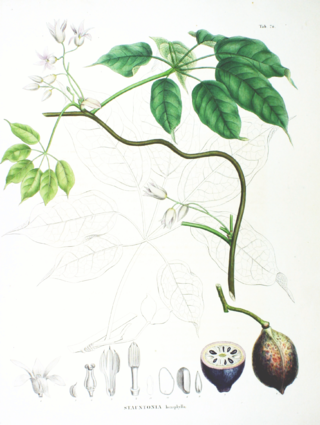
Stauntonia is a genus of flowering plants in the family Lardizabalaceae. It is named after George Staunton, who brought it to Britain from China in the 19th century.

Combretum indicum, also commonly known as the Rangoon creeper or Burma creeper, is a vine with red flower clusters which is native to tropical Asia and grows in thickets, primary and secondary forest, and along river banks in the Indian subcontinent, Malaysia and the Philippines. It has since been cultivated and naturalized in tropical areas such as Burma, Vietnam, and Thailand.

Astilbe chinensis, commonly known as false goat's beard, tall false-buck's-beard or Chinese astilbe, is a plant in the saxifrage family, Saxifragaceae. It is a perennial herb that grows near shaded streams and rivers. It is also commonly grown in shade gardens.

Persicaria chinensis, commonly known as creeping smartweed or Chinese knotweed, is a plant species from the family Polygonaceae. It is widespread across China, Japan, the Indian Subcontinent, Indonesia, Malaysia, and Vietnam. It is a common plant in Malaysia and Vietnam, where it is used in herbal remedies, such as for the treatment of dysentery, enteritis, and sore throat. It is a weed in some coastal areas of New South Wales and Queensland in Australia.

Iris domestica, commonly known as leopard lily, blackberry lily, and leopard flower, is an ornamental plant in the family Iridaceae. In 2005, based on molecular DNA sequence evidence, Belamcanda chinensis, the sole species in the genus Belamcanda, was transferred to the genus Iris and renamed Iris domestica.

Tamarix chinensis is a species of tamarisk known by the common names five-stamen tamarisk and Chinese tamarisk or saltcedar. It is native to China and Korea, and it is known in many other parts of the world as an introduced species and sometimes an invasive noxious weed. It easily inhabits moist habitat with saline soils. It may grow as a tree with a single trunk or as a shrub with several spreading erect branches reaching 6 metres or more in maximum height. It has been known to reach 12 metres. It has reddish, brown, or black bark. The small, multibranched twigs are covered in small lance-shaped, scale-like leaves which are no more than about 3 mm long. The inflorescence is a dense raceme of flowers a few cm long. Each fragrant flower has five petals which are usually pink but range from white to red.

Gonocarpus chinensis is an accepted Australian shrub in the watermilfoil family Haloragaceae (watermilfoil) native to eastern Australia, South China, Caroline islands and North Australia. It was introduced to the Hawaiian islands, United States and California, United States. G. chinensis is considered not to be a economically impotent genus but can be used for medicine and gardening as ornamental plants. This species lives in wet tropical regions, grasslands, riverbanks and in waste lands in elevations at 100 to 800 meters but at 1800 meters in Southwest China.
Helwingia chinensis is a plant species first described by Alexander Theodorowicz Batalin. Helwingia chinensis is part of the genus Helwingia and the family Helwingiaceae.

Stauntonia hexaphylla or Stauntonia vine is a plant in the family Lardizabalaceae.

Stauntonia purpurea is a plant in the family Lardizabalaceae.
Stauntonia trinervia is a plant in the family Lardizabalaceae. It is distributed in Guangdong and other parts of mainland China, and grows at an altitude of 350 to 500 meters above sea level in open forests beside water in valleys.
Stauntonia obovata is a plant in the family Lardizabalaceae. It is distributed in Taiwan and mainland China in Guangdong, Sichuan, Fujian, Guangxi, Jiangxi, Hong Kong, Hunan and other places. It grows in areas with an altitude of 300 to 800 meters, mostly in open forests or dense forests in mountain valleys.
Stauntonia brunoniana is a plant in the family Lardizabalaceae. It is distributed in Vietnam, India, Myanmar, and Yunnan in mainland China, and grows at an altitude of 900 to 1,500 meters above sea level, generally in mountain forests.
Stauntonia brachyandra is a plant in the family Lardizabalaceae.
Stauntonia cavalerieana is a plant in the family Lardizabalaceae. It is endemic to China.
Stauntonia yaoshanensis is a plant in the family Lardizabalaceae. Its native range is Guangxi and other provinces of SE China. It is a climber and grows primarily in the subtropical biome.
Stauntonia grandiflora is a plant in the family Lardizabalaceae. The native range of this species is South-Central China to Vietnam. It is a climber and grows primarily in the temperate biome.
Stauntonia chapaensis is a plant in the family Lardizabalaceae. The native range of this species is China to Vietnam. It is a liana and grows primarily in the subtropical biome.
Stauntonia conspicua is a plant in the family Lardizabalaceae. It is endemic to China, distributed in Zhejiang Province in mainland China. It grows at an altitude of 1,300 to 1,600 meters above sea level, often in dense forests on mountain slopes.
Stauntonia crassifolia is a plant in the family Lardizabalaceae. The native range of this species is Myanmar. It is a subshrub and grows primarily in the subtropical biome.








